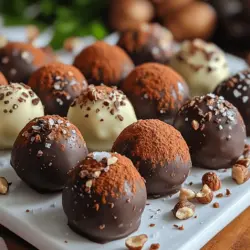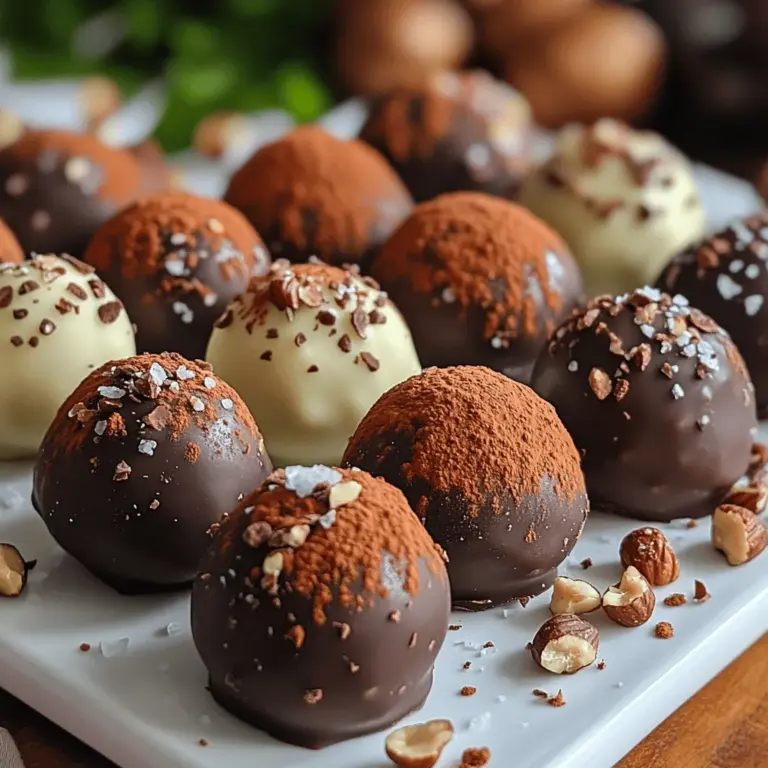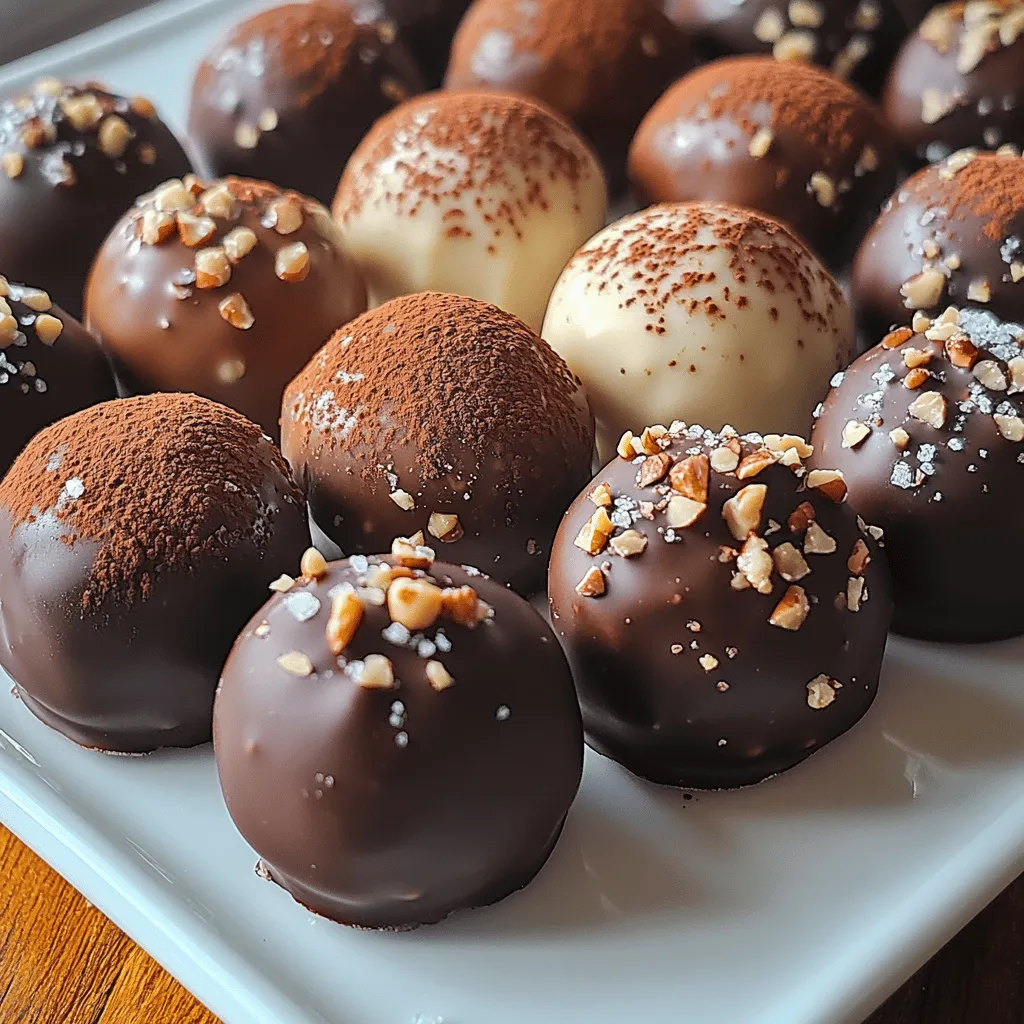There’s something undeniably delightful about chocolate desserts. They have an enchanting ability to lift our spirits, spark joy, and provide a moment of indulgence in our busy lives. Among the vast array of chocolate confections, few can rival the richness and elegance of truffles. These small, round bites of chocolatey goodness are synonymous with luxury, making them a popular choice for special occasions, gifts, or a well-deserved treat just for you.
The art of making truffles dates back to the late 19th century and has roots in France, where they were initially crafted as a way to showcase the versatility of chocolate. Unlike their more straightforward counterparts, truffles are considered a gourmet treat due to their rich ganache center and the various coatings that can elevate their flavor and texture. What sets them apart from other chocolate confections, such as bars or bonbons, is their decadent, creamy filling, typically made from a blend of high-quality chocolate and cream.
When it comes to crafting the perfect truffle, one of the most crucial elements is the chocolate itself. Using high-quality chocolate can make a world of difference in flavor and overall experience. The complexity of chocolate lies not only in its sweetness but also in its depth of flavor, which can range from fruity to nutty, depending on the type. For our Decadent Triple Chocolate Truffles, we will be incorporating three distinct types of chocolate—dark, milk, and white—each contributing its unique characteristics to create a beautiful balance of flavors.
Understanding the Basics of Chocolate Truffles
At its core, a chocolate truffle is a small, round confection made of a ganache center that is typically enrobed in a coat of chocolate or other materials like cocoa powder, nuts, or coconut. The ganache is made by heating cream and combining it with chocolate, resulting in a rich and velvety mixture that can be molded into various shapes and sizes.
The term “truffle” comes from the French word for the fungus of the same name, as the shape and appearance of these confections resemble the prized truffles found in nature. Unlike traditional candies, truffles are characterized by their soft, creamy center, which melts in your mouth, providing a luxurious experience.
While many people may confuse truffles with other chocolate confections, such as chocolate bonbons or pralines, the primary distinction lies in their texture and filling. Bonbons typically have a hard chocolate shell with a variety of flavored fillings, while pralines often include nuts or nougat. Truffles, however, focus on the rich, smooth ganache that forms the heart of the confection.
The Chocolate Spectrum: Dark, Milk, and White
The three types of chocolate used in our recipe—dark, milk, and white—each bring different flavor profiles and textures to the table.
1. Dark Chocolate: Known for its rich, intense flavor, dark chocolate is made from cocoa solids, cocoa butter, and sugar, with little to no milk content. Its complexity often includes notes of fruit, spice, or nuttiness, making it a favorite among chocolate aficionados. Dark chocolate has the highest cocoa content of the three types, which not only contributes to its bold flavor but also offers health benefits, including antioxidants.
2. Milk Chocolate: This variety is characterized by its sweetness and creamy texture, thanks to the addition of milk solids. Milk chocolate is generally less intense than dark chocolate, making it a popular choice for those who prefer a milder taste. Its smoothness and sweetness can balance the richness of dark chocolate in our truffles, creating a delightful contrast.
3. White Chocolate: While technically not a chocolate in the traditional sense, white chocolate is made from cocoa butter, sugar, and milk solids, lacking cocoa solids. This gives it a creamy, sweet flavor that can enhance the overall taste of the truffles. White chocolate plays a unique role in our recipe, providing a contrasting sweetness that complements the darker chocolates.
Ingredients Breakdown
Before diving into the recipe, it’s essential to understand the key ingredients that will help us create our Decadent Triple Chocolate Truffles.
– Dark Chocolate: Choose a high-quality dark chocolate with at least 60% cocoa content for depth and richness. The bitterness of dark chocolate will help balance the sweetness of the milk and white chocolate.
– Milk Chocolate: Use a smooth and creamy milk chocolate that you enjoy snacking on. The sweetness of this chocolate will play a crucial role in rounding out the flavor profile of the truffles.
– White Chocolate: Opt for a good-quality white chocolate that contains real cocoa butter. This will ensure that the flavor is rich and not overly sweet, providing a nice contrast to the darker chocolates.
– Heavy Cream: The backbone of our ganache, heavy cream is essential for achieving the right consistency. It adds richness and helps create that luxurious mouthfeel we expect from truffles.
– Unsalted Butter: Adding unsalted butter enhances the texture of the ganache, giving it a silky smoothness that melts in your mouth. The fat in the butter also helps stabilize the ganache.
– Vanilla Extract: A splash of pure vanilla extract enhances the overall flavor of the truffles, adding a subtle warmth that complements the chocolate.
– Coatings: The choice of coating is crucial for texture and flavor contrast. Cocoa powder offers a rich, intense chocolatey kick, while chopped nuts can add a crunchy element that pairs beautifully with the smooth ganache.
– Optional Garnish: A sprinkle of sea salt flakes on top of your truffles can elevate the flavor, creating a delicious sweet-salty contrast that enhances the chocolate experience.
Step-by-Step Instructions to Create Decadent Triple Chocolate Truffles
Now that we’ve covered the essential ingredients, it’s time to dive into the process of making your own Decadent Triple Chocolate Truffles. This recipe involves creating a luscious ganache and shaping the truffles, which can be done in a few simple steps.
Melting the Chocolate
To start, you’ll need to melt your chocolate. There are two popular methods for doing this: the double boiler method and the microwave method.
– Double Boiler Method: Set a heatproof bowl over a pot of simmering water, ensuring that the bottom of the bowl doesn’t touch the water. Add your chopped dark chocolate to the bowl and stir gently until melted and smooth. This method allows for gentle, even heating, which is essential for preventing the chocolate from seizing.
– Microwave Method: If you prefer a quicker approach, you can melt the chocolate in the microwave. Place the chopped chocolate in a microwave-safe bowl and heat in 30-second intervals, stirring in between, until melted and smooth. Be cautious not to overheat, as chocolate can easily burn in the microwave.
Preparing the Ganache
Once your chocolate is melted, it’s time to prepare the ganache. In a separate saucepan, heat your heavy cream until it’s just about to simmer. Pour the hot cream over the melted chocolate, allowing it to sit for a minute to help the chocolate melt further. Gently stir the mixture with a spatula or whisk until the ganache is smooth and glossy.
Chilling the Ganache
After your ganache is prepared, it’s crucial to let it cool to room temperature before placing it in the refrigerator. Chilling the ganache is a necessary step, as it allows the mixture to firm up, making it easier to scoop and roll into truffles. Aim for a chilling time of at least 1-2 hours, but keep an eye on it to ensure it doesn’t become too firm.
Rolling the Truffles
Once the ganache has set, it’s time to roll your truffles. Using a melon baller or a small spoon, scoop out portions of the ganache and quickly roll them between your palms into smooth balls. It’s best to work quickly, as the warmth from your hands can soften the ganache.
Coating Options
As you finish rolling your truffles, you can start thinking about how you want to coat them. You might opt for a simple dusting of cocoa powder for a classic touch, or roll them in finely chopped nuts for added texture. Alternatively, consider dipping them in tempered chocolate for a glossy finish.
In this decadent journey of creating Triple Chocolate Truffles, every step is a celebration of the rich and varied world of chocolate. With a careful balance of flavors and textures, these truffles will not only satisfy your sweet tooth but also impress anyone lucky enough to share in this luxurious treat. Stay tuned for the next part of this article, where we’ll delve deeper into the finishing touches and garnishing your truffles for the ultimate indulgence.
Optional Garnishing Techniques for Enhanced Presentation
Garnishing is an art that elevates the appearance of any dish, and your triple chocolate truffles deserve to shine. Here are several techniques to enhance their presentation:
1. Cocoa Powder Dusting: For a classic look, lightly dust the truffles with unsweetened cocoa powder. This not only adds a touch of elegance but also complements the rich chocolate flavor.
2. Chocolate Drizzle: Melt some extra chocolate (white, milk, or dark) and drizzle it over the truffles using a fork or piping bag. This adds a decorative flair and a visual contrast that makes your truffles look professionally crafted.
3. Chopped Nuts: Roll the truffles in finely chopped nuts like pistachios, hazelnuts, or almonds. This adds texture and a nutty flavor, enhancing both the look and taste of your truffles.
4. Edible Gold Leaf: For a luxurious touch, consider adding edible gold leaf to the top of each truffle. This will create a stunning visual impact, perfect for special occasions.
5. Herbs and Spices: A sprinkle of sea salt or a few flakes of fleur de sel can add a sophisticated touch, enhancing the chocolate’s flavor profile. Fresh mint leaves can also be a refreshing garnish that adds color.
The Science of Chocolate Melting and Ganache Formation
Understanding the science behind chocolate is essential for creating the perfect ganache for your truffles. Here’s a breakdown:
Explanation of the Melting Point of Different Chocolates
Chocolate is a complex ingredient with varying melting points depending on its type. Dark chocolate generally melts between 115°F to 120°F, milk chocolate around 110°F to 115°F, and white chocolate at about 100°F to 110°F. This variance is due to the different fat contents and cocoa solids in each type of chocolate. Knowing these temperatures helps prevent overheating, which can lead to a burnt taste or a grainy texture.
How the Fat Content in Cream Influences Ganache Texture
The type of cream you use directly impacts the ganache’s texture. Heavy cream, which contains 36-40% fat, creates a rich and silky ganache, while lighter creams will yield a thinner consistency. The fat in the cream integrates with chocolate during melting, resulting in a luscious and smooth ganache that coats the truffles perfectly. For firmer truffles, you can increase the chocolate-to-cream ratio.
The Emulsification Process: Why It Matters in Achieving a Glossy Finish
Emulsification is the process of blending two liquids that do not typically mix, such as fat and water. When making ganache, whisking the melted chocolate and cream together creates an emulsion, allowing the fat to evenly distribute and bind with the liquid. This results in a glossy finish and helps the truffles hold their shape. To achieve the best results, ensure the chocolate is completely melted before adding the cream and whisk vigorously until smooth.
Creative Variations of Triple Chocolate Truffles
Once you’ve mastered the classic triple chocolate truffle, it’s time to get creative. Here are some ideas to elevate your truffle game:
Flavors to Consider Adding: Infused Oils, Spices, or Liquors
Experimenting with different flavors can lead to exciting variations of your truffles. Consider adding:
– Infused Oils: A few drops of orange or peppermint oil can transform your truffles into a flavored delight.
– Spices: Cinnamon, cardamom, or chili powder can add warmth and complexity.
– Liquors: Incorporate spirits like rum, bourbon, or coffee liqueur for an adult twist. Just be cautious with amounts, as too much liquid can affect the ganache’s consistency.
Alternative Coatings: Coconut Flakes, Crushed Cookies, or Sprinkles
Don’t limit yourself to just cocoa powder or chocolate coating. Get creative with your coatings:
– Coconut Flakes: Roll truffles in sweetened or unsweetened coconut flakes for a tropical flair.
– Crushed Cookies: Oreos, graham crackers, or digestive biscuits can add a delightful crunch.
– Sprinkles: Colorful sprinkles can make your truffles festive and appealing for parties or holidays.
Incorporating Fruits or Other Fillings for Added Complexity
Adding fillings can create a delightful surprise in each bite. Consider these options:
– Fruit Purees: Incorporate raspberry or passion fruit puree into the ganache for a fruity twist.
– Nuts or Dried Fruits: Chopped almonds, walnuts, or dried cherries can add texture and flavor.
– Caramel or Nut Butters: A small dollop of caramel or nut butter in the center of each truffle can create a rich and decadent filling.
Storing and Serving Suggestions
To ensure your triple chocolate truffles remain delicious and visually appealing, proper storage and serving techniques are essential.
Optimal Storage Conditions for Maintaining Freshness
Store your truffles in an airtight container in a cool, dry place. If you live in a warm climate, refrigeration may be necessary, but allow them to come to room temperature before serving to enjoy their full flavor and texture. Properly stored, your truffles can last for up to two weeks, though they are likely to be enjoyed long before that!
Presentation Ideas for Serving Truffles at Events or Gatherings
When it comes to serving, presentation is key:
– Truffle Boxes: Place truffles in decorative boxes or bags for gifting.
– Serving Platters: Arrange truffles on a cake stand or a beautiful platter with fresh fruits or edible flowers for a stunning display.
– Individual Cups: Use small cupcake liners or candy cups for an elegant touch, especially when serving at parties.
Pairing Suggestions: Beverages That Complement Chocolate Truffles
Enhance the experience by pairing your truffles with complementary beverages:
– Coffee: A rich espresso or a creamy cappuccino can balance the sweetness of the truffles.
– Tea: Consider pairing with black tea or a spiced chai for a delightful contrast.
– Wine: A glass of red wine (like a Cabernet Sauvignon) or dessert wine (like port) can elevate the flavor profile.
Health Considerations and Ingredient Substitutions
While chocolate truffles are a treat, being mindful of health considerations is essential for many.
The Nutritional Aspects of Chocolate in Moderation
Dark chocolate, in particular, has several health benefits, including antioxidants and potential heart health advantages. Consumed in moderation, chocolate can be part of a balanced diet. Remember that moderation is key; these truffles should be enjoyed as a delightful indulgence rather than a daily staple.
Suggestions for Healthier Alternatives: Using Dark Chocolate, Reducing Sugar, or Dairy-Free Options
If you’re looking to make your truffles healthier, consider these substitutions:
– Dark Chocolate: Opt for chocolate with at least 70% cocoa content for a richer flavor with less sugar.
– Sugar Alternatives: Use natural sweeteners like maple syrup or agave nectar, or reduce the overall sugar content in your recipe.
– Dairy-Free Options: Substitute heavy cream with coconut cream or nut milk to create a vegan version of your truffles.
Allergen Considerations and Substitutions for Those with Dietary Restrictions
It’s essential to consider dietary restrictions, especially if you’re serving guests. Here are some tips:
– Nut Allergies: Use nut-free chocolate and avoid any nut-based coatings.
– Gluten-Free: Ensure any coatings (like crushed cookies) are gluten-free.
– Vegan/Dairy-Free: As mentioned, use plant-based alternatives for cream and chocolate.
Cultural Significance of Chocolate in Culinary Traditions
Chocolate is not just a treat; it holds cultural significance around the world.
The Role of Chocolate in Various Cultures and Celebrations
Throughout history, chocolate has been celebrated in various forms. From the Aztecs, who used cacao beans as currency, to modern-day celebrations like Valentine’s Day, chocolate symbolizes love, indulgence, and celebration.
How Truffles Fit into the Broader Category of Confections Around the World
Truffles, in their various forms, are a staple in many cultures. French truffles are often filled with ganache, while Italian variations may include liqueurs or nuts. Understanding these traditions can inspire your creations and deepen your appreciation for this beloved treat.
The Evolution of Chocolate Desserts Over Time
Chocolate desserts have evolved significantly over the years. From simple chocolate bars to intricate desserts like soufflés and ganaches, the versatility of chocolate continues to inspire chefs and home bakers alike. Truffles are a perfect example of this evolution, combining the rich flavors of chocolate with creative fillings and coatings.
Conclusion
Homemade triple chocolate truffles are a luxurious treat that encapsulates the joy of chocolate in every bite. The decadence of these truffles, combined with the ability to experiment with flavors, coatings, and presentations, makes them a delightful project for any chocolate lover.
Encourage yourself to explore variations and try different techniques, and remember, the process of making these truffles is as enjoyable as savoring them. Share your creations with loved ones, and relish the joy that homemade treats can bring to any occasion. After all, few things are as rewarding as presenting a beautifully crafted dessert that you made with your own hands. Enjoy the indulgence and the smiles they bring!


